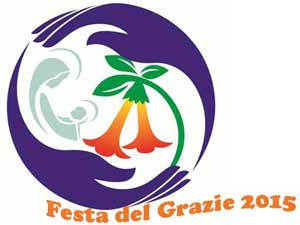PHONE
0364-2534588

The feast of gratitude at the world level will be celebrated in Cochabamba this year in the Bolivian Province of Our Lady of Peace (BOL) on April 25-26, 2015.
As was announced in a letter sent to all Provincials and Superiors of Pre-Provinces by Sr. Chiara Cazzuola, Vicar General, all the educating communities will be involved in the preparations for this family moment.
The theme proposed by the Province: ?Grow and flourish with the young where God wants us?, will help us deepen the dimension of obedience. As we read in the Constitutions, this is the axis of our life because it is closely tied to the mission and its community character (Cf. C 32). This is what the theme of the feast intends to highlight, underlining ?with the young? in an explicit recall to GC XXIII. The Biblical text chosen, ?Those who are planted in the house of the Lord shall flourish? (Psalm 92: 14), proclaims the meaning of our presence in the house of the Lord.
The LOGO is represented by the national flower of Bolivia, the Kantuta, a flower that is already sacred for the Incas. It blossoms in the winter, even in arid regions, overcoming adversity. It is the flower of reconciliation and of hope. Its twisted branches are like many cordial embraces.
The colours of the Kantuta, besides giving rise to the colours of the Bolivian flag, are the sign of love and fraternity and have a special significance:
In the LOGO are seen two open hands that express the international and intercultural character of the Institute, with the attitude of going out to the periphery in the spirit of the words of Mary to Don Bosco, ?Take care of them. They are my children!? The image of the Virgin recalls her presence in the life of the Institute and in that of the Bolivian people.
Our Sisters of Bolivia propose that every Province send a graphic representation, or with some other technology, the national flower or another symbol typical of the culture of the country where the Province is found. This will be the SIGN that expresses the convergence of the entire Institute in grace to la Madre.
This can be emailed to Sr. Espinoza Miguelina at the following address:
secretariabol@gmail.com

Using the same modality, Bolivia will send every Province the Kantuta flower. During the days of the feast, this will be placed on the altar as an expression of gratitude to the Lord for Mother Yvonne, for the life of the Institute, and for every educating community.
In addition, we are invited to prepare for the Feast of Gratitude by making a journey in three phases that recall the Pope?s Letter for the Year of Consecrated Life. Each phase will be characterized by a colour of the Kantuta:
Red. Look at the past with gratitude
How shall we look at the past?
Recall with the community and be grateful for the riches and the gifts God has sown at the Church, Institute, and community levels.
Yellow. Live the present with passion and joy.
How shall we live the present?
With the young people open to the Spirit, let us go out to the peripheries in an attitude of reciprocity.
Green. Embrace the future with hope.
How shall we open ourselves to the future?
In community with the Church, we renew our covenant through concrete gestures of love and fraternity.
The feast of la Madre seeks to be a time of solidarity at the Institute level.
This year, the offerings will contribute to the functioning and development of the Main House of Santa Cruz, Bolivia, for children and girls at risk, and for other urgent needs of the Institute.
In order to favour the preparation and the involvement of the educating communities in this family feast, a dossier will be offered later on the Institute web site containing some information relative to the Bolivian nation, to the origin, and the actual reality of the Province.